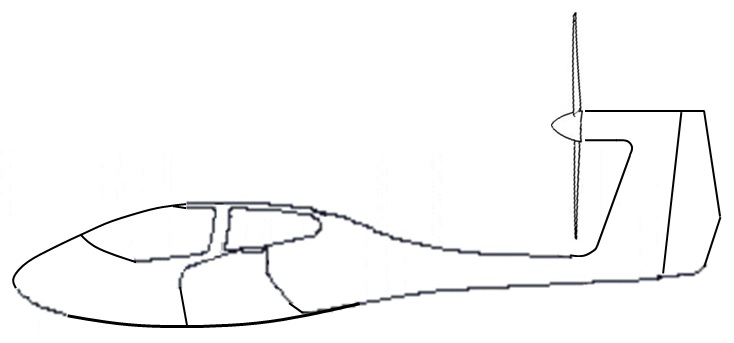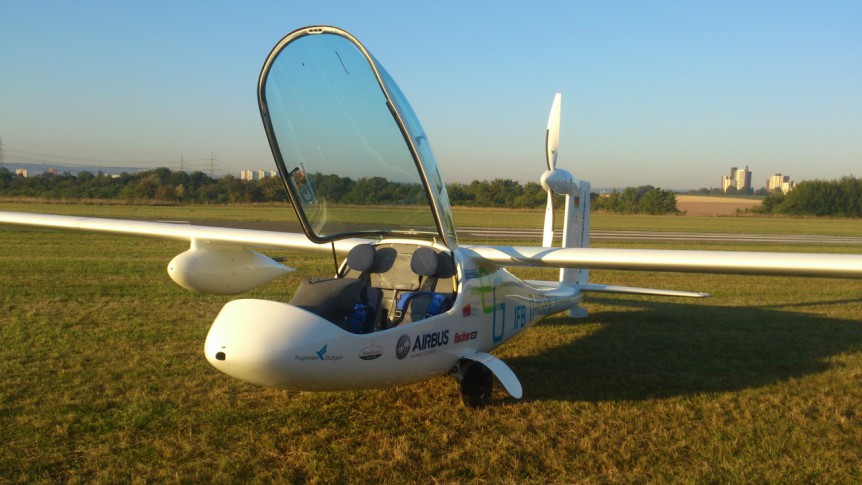A Big Win for Stuttgart Team Dipl-Ing Ingmar Geiß, Deputy Project Leader for e-Genius at the Institute of Aircraft Design at the University of Stuttgart, shared this pleasant news: “I am happy to tell you that our hybrid-electric “ECO4” has won the Berblinger Prize 2016. ECO4 combines an optimized electric airframe with a modern combustion engine generating electricity. This combination leads to an aircraft which cruises at 120 knots and consumes 40 percent less fuel than comparable state-of-the-art airplanes with conventional propulsion. As a further advantage, a small but powerful battery system enables a silent take-off without the combustion engine running, reducing significantly the noise emissions.” The Berblinger Prize Gunter Czisch, mayor of Ulm, presented the 23,000 euro ($24,035 US) prize to the team, which intends to invest the amount “directly into the further development of the airplane.” The prize was founded in recognition of Albrecht Ludwig Berblinger, “the little tailor of Ulm, who tried to cross the river …
e-Genius Flies with a Range Extender
Stuttgart to Barcelona Dipl-Ing* Ingmar Geiß, Deputy Project Manager for e-Genius with the Institute of aeronautical engineering at Stuttgart University shared the news that e-Genius flew with its range extender for the first time on September 15. He notes that while the battery-powered airplane can manage trips up to 300 kilometers (186 miles), the hybrid engine/generator pod will enable flights up to 1,000 kilometers (620 miles). This would equal a trip from Stuttgart to Barcelona, Spain, according to the e-Genius web site. As the school explains, “With [the] e-Genius hybrid most flights of a typical user case can be done in the cost and energy efficient battery mode – for all longer flights the range extender can be used. Generator system control requires no pilot input, everything being done automatically. If the pilot wants to set down at the end of a trip with a certain amount of battery energy on board, e-Genius has an ingenious “look-ahead” feature to modulate …
G4 to HY4 – Swapping Batteries for Fuel Cells
The University of Stuttgart and Pipistrel started down similar paths around 2007, with the Stuttgarters attempting a hydrogen-powered two-seat aircraft, the Hydrogenius; and Pipistrel developing a self-launching craft with either two-stroke power or an equivalent electric motor. The two groups came to rely on one another, with hydrogenius using the forward fuselage and wings of the Taurus G2 with hydrogen tanks in the fuselage and a Sineton motor on the tail. On February 27, 2008, Professor Rudolf Voit-Nitschmann, the father of the solar powered aircraft Icare 2 and the unofficial World Record holder for distance flown in a solar powered aircraft, along with dipl. ing. Steffen Geinitz and dipl. ing. Len Schumann met with Pipistrel leaders, including CEO Ivo Boscarol and designer Tine Tomazic at the company headquarters in Ajdovscina. Because the area aft of the wing was different for the Pipistrel G2 and Hyrogenius, the fuselages looked entirely different. Hydrogenius used the volume behind the wing to stow the H2 …
SmartFlyer – an Electric Four-Seater?
The people behind the Smartflyer, a Swiss design concept now under development ask, “Why does the Smartflyer look like this? With a tail-mounted electric motor, it’s a bit reminiscent of e-Genius, and also a bit like a strutless Rutan Skigull. In fact, the basic configuration has been used on many significant aircraft over the last several decades, as a segment of Smartflyer’s web site shows. As Herr Professor Dipl-Ing. Rudolf Voit-Nitschmann, Project Leader on e-Genius explained, several benefits accrue from this arrangement of aerodynamic elements. Compared to a conventional touring motor glider a substantial larger propeller-diameter can be realized without a high and consequentially heavier undercarriage. Therefore the propeller-efficiency will increase. The front body part has the aerodynamic quality of a modern glider (no vorticities and local impact pressure peaks) and thus a very small drag. The propeller is optimally protected from ground contact. Electric motors are light enough to mount on a tail and are therefore able to benefit from that placement while …
Germany to Two Places in Austria – On Solar Wings
e-Genius spent July 4 crossing the Alps both ways from Germany to Italy, a first for a two-seat, battery-powered airplane. Although the Elektra One Solar from PC-Aero GmbH is lighter and seats only one, its flights starting two weeks before and ending two days before e-Genius’s journey are equally proud accomplishments. The outgoing flight started in Unterwössen, Germany on June 25, crossed over the Grossglockner and landed, according to PC-Aero’s description, “In the sunny town of Lienz in East Tyrol, Austria. The flight took around 2.5 hours. After the successful flight on the south side of the Alps, Elektra One Solar started [on its next trip] on 2 July (few days before the eGenius of the University of Stuttgart also flew over the alps) in quite difficult weather conditions. Despite headwinds and strong gusts the plane crossed the Alps at an altitude of more than 3,000 meters and landed after about 2 hours and 190 kilometers (117.8 miles) [in] flight, as …
e-Genius Crosses the Alps on Battery Power – Twice!
It makes your editor’s morning to receive such wonderful emails. Dipl. Ing. Ingmar Geiß, Deputy Project Manager for Overall Aircraft Systems on e-Genius wrote the following: “We had a great Saturday – we flew from Stuttgart over the Alps to Italy, recharged the batteries and flew back on the same day! For us, this shows the practicability of battery powered aircraft and we think this is a milestone towards an eco-friendly and efficient aviation.” The e-Genius web page on the University of Stuttgart site expands on the story, describing the flight’s accomplishment. “A milestone towards an energy efficient and carbon-neutral aviation has been reached.” While Americans rested up for their Fourth of July festivities, “Saturday morning, the electric aircraft “e-Genius” flew from the airfield Hahnweide near Stuttgart over the Alps to Italy. On its way to the north-Italian airfield Calcinate del Pesce, the hi-tech aircraft had to cover a distance of 320 kilometers (198.4 miles) and climbed to an altitude …
e-Genius Extends Its Range
Shown at the E-Flight Expo at Friedrichshafen’s Aero 2015, Stuttgart University’s e-Genius had an aerodynamic-looking pod next to one wing, containing an ENGIRO range extender consisting of a Wankel-type engine and a generator. The unit could, as its name implies, help e-Genius go for new records to add to its already significant collection. Bill Lofton at EV Hangar has detailed the extender, now associated with the e-Genius and in a larger variant on the Equator P2 amphibian being built in Norway by Tomas Broedreskift. Equator’s web site describes its power system: “The hybrid propulsion system being developed by Equator is called EHPS (Equator Hybrid Propulsion System). The engine specific project is being co-funded by Transnova and the company doing the development work with us on this is ENGIRO. We will design a custom engine and generator specified specifically for the P2. Power out in the prop is 100kW (approx. 130HP) and the generator will produce 57-60kW of power charging the batteries. The combustion …
Powering Imagination at the Museum of Flight
Powering Imagination, a symposium devoted to that premise and to encouraging the development of electric aviation, achieved both goals on Saturday, February 28 at Seattle’s Museum of Flight. Organized by Erik Lindbergh and Eric Bartsch, the gathering included two panel discussions and eight presentations that helped define where the world of electric flight might be heading. Between 10:00 a.m. and 5:00 p.m., presenters covered a lot of ground. Following Cale Wilcox, the Public Programs Coordinator for the Museum’s, introduction, Erik Lindbergh took the stage to explain the goals of the Powering Imagination organization, including making aviation clean, quiet, exciting and affordable. This democratization of flight mirrors aspirations of the CAFE Foundation and is reflected in the educational efforts made by Lindbergh’s organization. He explained that the X-Prize helped jump start private space flight, then asked how we translate that interest into helping form an electric aircraft industry. Development of this new industry may be crucial to aviation’s survival, with its …
e-Genius, Klaus Ohlmann Set Records, Records, Records!
“Records, Records, Records!” heads the news on the Institut for Flugzeugbau (IFB) web site this morning. The sub-head reads, “Experienced hands plus a high-performance airplane plus one week equals seven world records.” Admitting to fuzzy math, the writer still draws a clear line to the seven records. Klaus and e-Genius spent the third week of July in Seeres – La Bâtie, France where they achieved seven FAI (Fédération Aéronautique International) World Records in the Category of Electric Airplanes. According to the IFB, “In two flights (July 18th and 19th) he attained: – Speed on a 100 km round trip : 178.1 kilometers per hour (96 knots, or 110.4 mph) – Speed on a 500 km round trip : 93.03 km/h (50 kt – 57.5 mph) – Distance of 504 km (312 miles) – Absolute altitude of 6,376 m MSL (20,918 feet) – Time to climb to 6,000 m (20,000ft) : 1:53 min (an average of about 177 feet per minute) …
The Green Speed Cup – Fourth Edition
Robert Adam helps run the Green Speed Cup, a time, speed and economy run for aircraft in Germany. The rules for this year’s contest elucidate the intent and ambitions for the event: “The GREEN SPEED CUP is an aviation competition focusing on efficient flight. The emphasis lies on fast and energy saving transportation. The competition is meant to develop new methods to reduce energy consumption of motor driven aircraft using external energy sources like lateral winds and updrafts. In making the ability of certain aircraft and techniques transparent, the competition shall set new standards in general aviation.” The Cup provides a sounding board for discussion of energy efficient flight and the changing experience of flying while exploring new techniques and technologies. Hosted by STEMME Aviators e.V., the contest is open to “all aircraft capable of taking off under their own power,” with the following restrictions: In the Electric Class, airplanes may have one to four seats, weigh up to 2,700 …


